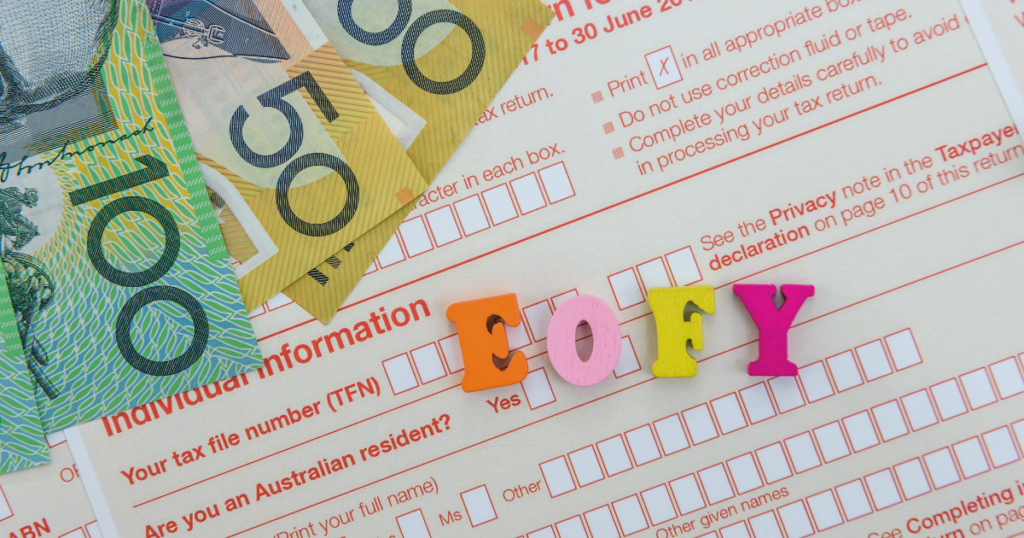The end of the financial year (EOFY) is more than just a time for compliance – it’s a crucial period for reflection, planning, and setting your business up for success in the upcoming year. This comprehensive guide provides actionable steps to organise your business finances, maximise tax returns, and optimise operations.
For the best EOFY experience, download our comprehensive checklist. It covers everything from gathering records to reviewing insurance and planning for the future. Leverage the checklist to streamline your EOFY and set your business on the path to success!
What should small businesses do during EOFY?
The foundation of a smooth EOFY is securing documents on your business’s income, expenses, and payroll reports. The more organised these documents are, the more prepared you’ll be to file your tax returns, comply with the Australia Tax Office’s (ATO) regulations, and confidently embark on the 2024/25 financial year.
Make sure you are aware of your tax obligations, and mark your calendar with the key EOFY dates. If some tax rules applicable to your business are too complex, consider consulting a registered tax agent.
The Australian tax season runs from May to June every year, and your EOFY routine should be set in stone to avoid any compliance risks.
The complete EOFY checklist: Everything small businesses need to do to end on a financial YES!
Below is a roadmap for small businesses to navigate the EOFY 2023/24 in Australia.
1. Review financial reports and documentation
Financial reports highlight areas where your business excels and areas that need improvement. By understanding your finances, you can make data-driven decisions about future investments, staffing, or marketing strategies.
Prepare a summary of your income and expenses through a profit and loss statement, and ensure all records of debtors and creditors are up to date. Conduct a stocktake if applicable, and review your asset records for depreciation claims and capital gains tax purposes.
2. Handle your income tax obligations
Your tax return acts like a bridge between your business and the government. By accurately reporting your income and expenses, you might be eligible for tax deductions, which work like shields protecting a portion of your profits from taxes.
Complete and lodge your income tax returns, along with any applicable reports for PAYG withholding, fringe benefits tax (FBT), and goods and services tax (GST). Don’t forget to finalise income statements for Single Touch Payroll. Explore tax deductions for expenses like website setup, vehicle, travel, and home office costs, and verify your eligibility for small business tax concessions.
Learn more from the ATO website.

3. Comply with superannuation requirements and payments
As a business owner in Australia, you have a responsibility towards your employees’ superannuation (super) during EOFY. You need to pay super for eligible employees at least four times a year, the final deadline being 30 June of each year.
Make sure you meet all superannuation requirements on time to benefit from tax deductions. Consider providing your employees with a payment summary for their tax return, including their super contributions. Since record-keeping is key to every EOFY, it’s also a good opportunity to make digital backups of essential documents.
4. Verify your tax agent’s credentials
A qualified tax agent can identify potential tax deductions you might miss, potentially saving you money. They can also represent you if you’re ever audited by the ATO. If you’re using a tax agent this year, check if they’re registered with the Tax Practitioners Board (TPB) to make sure you get legitimate and professional advice.
Simply visit the Tax Practitioners Board (TPB) website and search for your agent’s name or registration number. The register will confirm if they are a registered tax agent or Business Activity Statement (BAS) agent, their area of practice, and any disciplinary history.
If you’re using a tax agent for the first time, try to ask for references from other businesses and schedule a one-to-one consultation to get a better understanding of their services.
5. Stay updated on tax rules and beware of scams
The ATO website is your best resource! Check it out periodically for important tax updates, deadlines, or regulation changes. Many industry associations and professional bodies also offer resources and updates on tax matters related to your specific sector.
With all the tax processes done online, EOFY scams have started to become more common. Be wary of emails or phone calls claiming to be from the ATO. Scammers often use scare tactics and pressure to trick you into revealing personal or financial information.
6. Review business performance
EOFY is a prime opportunity to step back and assess your business performance over the past year. Analyse whether you met your financial targets and identify areas for improvement. Use this insight to adjust your business and marketing plans for the new fiscal year.
Take note of industry benchmarks to compare your business with others of similar size in the same sector. If you feel lost, consult a business advisor or financial professional for additional insights and recommendations.
7. Reassess the current business structure
As your business develops and grows, your initial structure might no longer be the most efficient or beneficial. Changes here can significantly impact your tax and legal obligations in the next financial year.
Compare your current business structure and goals and assess whether they’re a good fit. Are you aiming for significant growth, or do you prefer a smaller, manageable operation?
8. Review insurance and risk management strategies
Reviewing your insurance policy at the End of the Financial Year (EOFY) helps you secure adequate coverage for any new equipment, services, or employees. Take a close look at your existing policy to ensure you fully understand the terms, exclusions, and limitations of your coverage.
You might find areas where you can negotiate better terms or adjust your coverage levels to optimise your premiums.
Remember, external factors like cyber threats or legal changes can alter your business’s risk landscape. Reviewing your policies ensures you’re covered for emerging risks that weren’t present when you initially obtained your insurance.
9. Prepare for FY 2024/25!
Leverage your learnings from this EOFY to introduce improvements to your business. Gather and analyse customer feedback throughout the year. This valuable information can help refine your products or services to meet customer needs in the coming year.
With organised financial documentation, you may find the resources to invest in growth or security, depending on your priorities. So, use the EOFY to start planning and setting your milestones!
Find out more about annual reporting: ato.gov.au
Keep your small business on track and compliant with Payroller – Download our EOFY checklist!
A successful new financial year starts with a positive mindset. Celebrate your achievements and maintain momentum by focusing on your long-term vision. To make sure you have a smooth and successful year-end, download our FREE EOFY checklist for small businesses below.
